Top 10 Automated Payroll Systems Every Business Should Try 2025
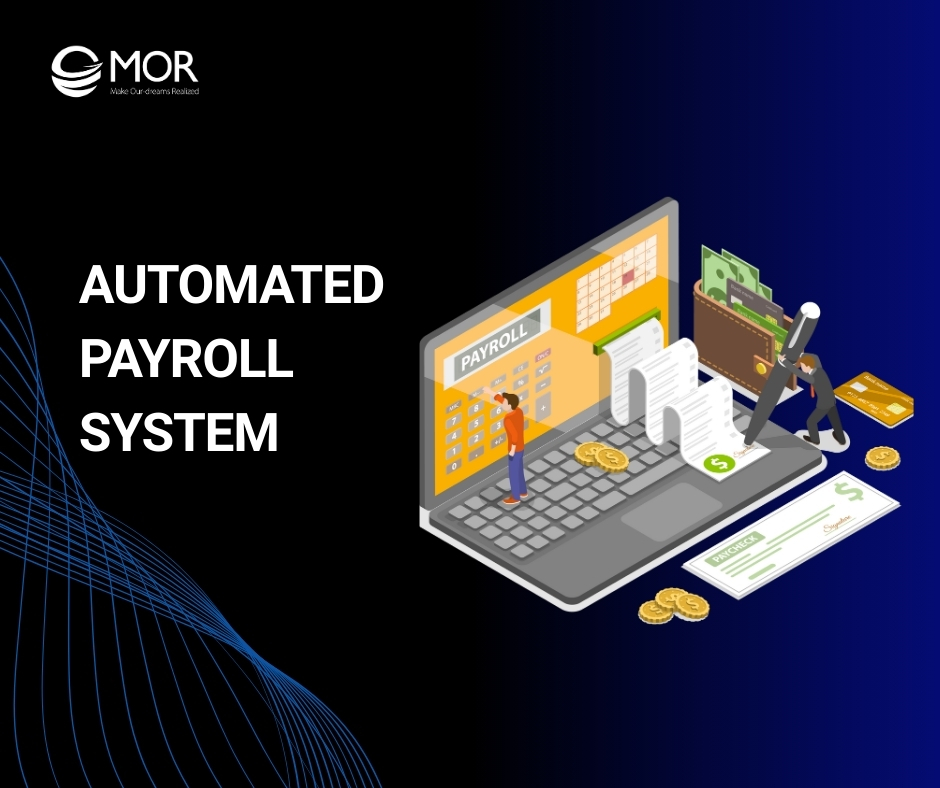
Managing payroll by hand is stressful, time-consuming, and prone to mistakes. An automated payroll system combined with modern payroll automation can ease the pressure, cut errors, and free HR teams to focus on bigger goals. In this guide, MOR Software will walk you through the top 10 automated payroll systems every business should try in 2025.
What Is An Automated Payroll System?
An automated payroll system is designed to handle payroll tasks faster and with fewer errors than manual methods. It has become a central part of modern workforce management because it saves time and improves accuracy.
From wage calculation to payroll tax deductions and pay slip generation, the system takes over repetitive work that once consumed HR and finance teams. With this payroll management system in place, staff can shift focus to projects that bring higher business value.
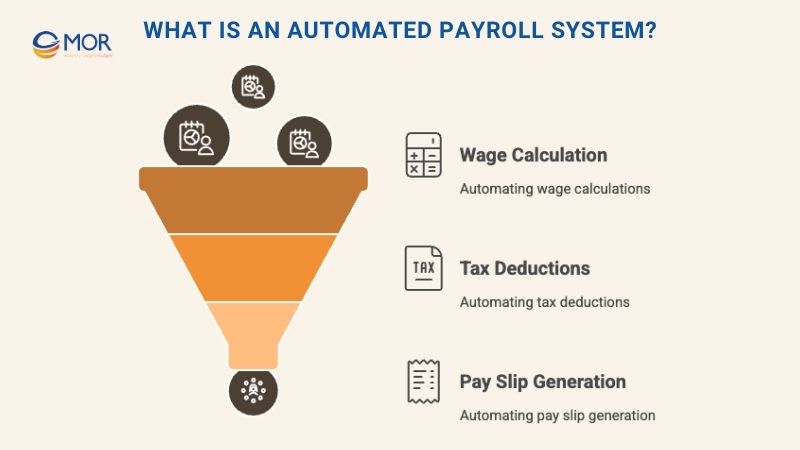
According to a recent Workday report, 92% of payroll professionals and executives see payroll as strategically important, yet 89% believe their current setups still fall short. This shows why companies are turning to automation, which transforms payroll into a more reliable and efficient process.
Key Benefits Of Automated Payroll System
An automated payroll system does more than replace manual work. It helps companies streamline payslip operations, cut down on mistakes, and turn payroll into a function that supports business strategy. Manual payroll requires heavy effort and often leads to errors, while payslip software saves time and delivers accurate results.
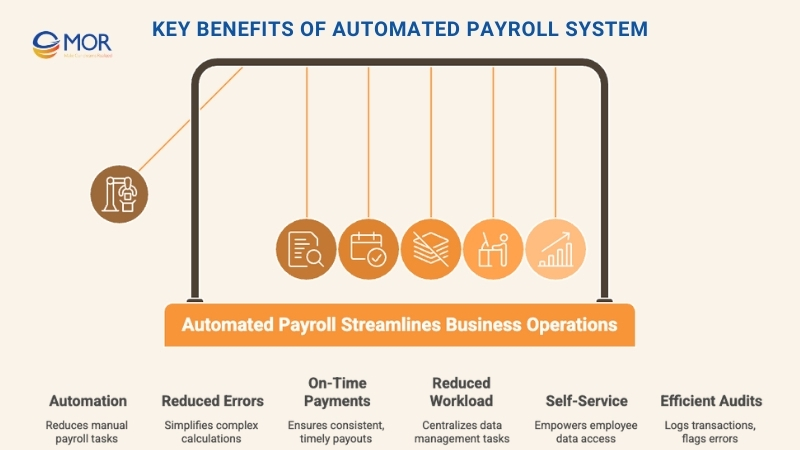
The main advantages include:
Simplify Complex Calculations
An automated payroll solution quickly handles tax brackets, overtime rates, and benefit allocations, even as laws and rules change. Updates are applied automatically, which keeps every calculation compliant with the most recent standards. Payroll teams can count on automation to reduce mistakes and eliminate repetitive adjustments.
Did you know? According to Workday’s Strategic Ascent of Global Payroll Report, 87% of payroll professionals say increasing payroll complexity is one of their biggest challenges.
Consistently Deliver On Time
Delays in payroll often create frustration among employees and complicate financial planning. Manual methods make these delays common, and research shows that 99% of organizations process payroll retroactively, resulting in more than 300 off-cycle payments caused by errors each year.
With automated payroll services, companies can process every pay cycle on time, regardless of workforce size or last-minute adjustments. This reliability builds trust and keeps payroll running smoothly.
Reduce Administrative Workloads
Payroll involves more than just issuing paychecks. It also includes compliance tracking, maintaining employee data, generating reports, and updating records. An automated payroll system brings these activities into one unified platform, automating their execution to cut administrative tasks and give better visibility into payroll information.
Workday’s report highlights that over one-third of business leaders see fragmented systems as a major barrier to effective payroll. With automation of payroll centralized on a single platform, HR and finance teams gain easier access to information and use payroll data in more strategic ways.
Improve Employee Self-Service
A modern automated payroll system often includes self-service portals, giving employees the ability to view pay stubs, update personal details, or track tax filings without relying on HR. This cuts down on repetitive requests and helps staff manage their own information with ease.
Self-service has quickly become the new standard. According to the American Payroll Association, 83% of employers now provide instant access to pay and benefits data, which shows how payroll transparency is becoming the norm.
Make Auditing More Efficient
Errors in payroll can result in legal exposure and expensive corrections. With automated payroll processing, companies have access to strong auditing tools that flag discrepancies and simplify error resolution. Every transaction is logged and ready for review, making compliance easier and less time-consuming for HR and finance.
As Jenn Pottorf, Director of Financial Services at Tulsa County, explained, moving to a fully integrated payroll system with self-service and real-time reporting allows for faster turnaround and better service across the organization.
>>> READ MORE: Differences Between Payslip vs PayStub For Businesses To Choose
Core Features Found In A Leading Automated Payroll System
An automated payroll system transforms the way payroll operates by automating every stage of payroll management. This improves accuracy, reduces errors, and increases overall efficiency. The breakdown below shows how automation strengthens payroll tasks compared to traditional manual processes.

Wage Calculation And Overtime Tracking
Manual payroll
Involves cross-checking time sheets and applying overtime rules by hand, which often leads to mistakes and inconsistencies.
Automated payroll software
Manages complex pay structures, including employee paycheck stub, hourly wages, and overtime, with speed and precision. Updates happen instantly, keeping calculations correct and reliable.
Tax Withholding And Compliance Updates
Manual payroll
Requires HR teams to track new regulations and apply them manually, which raises the chance of mistakes and noncompliance.
Automated payroll system integration
Accurately calculates and withholds federal, state, and local taxes while staying updated with changing laws automatically. This keeps payroll consistent and compliant without extra manual effort.
Managing Benefits And Deductions
Manual payroll
Calls for constant attention and updates to handle benefits, making the process slow and error-prone.
Automated payroll processing
Applies contributions and deductions for retirement, insurance, and garnishments automatically, cutting down on manual work and ensuring accuracy across every pay cycle.
Direct Deposit And Payment Distribution
Manual payroll
Demands manual verification of amounts and processing each payment separately, which takes extra time and effort to complete payroll runs.
Automated payroll services
Send payments automatically through direct deposit or other electronic methods, ensuring faster distribution and reducing the workload for payroll teams.
Employee Record Management
Manual payroll
Relies on separate documents or disconnected systems, which often leads to outdated data and inconsistencies.
Automated payroll software
Continuously syncs employee records, capturing updates like salary changes, new roles, or tax details automatically to keep information accurate and current.
Time - Tracking Integration
Manual payroll
Needs payroll staff to reconcile time cards and attendance logs by hand, which often slows down the process.
Automated payroll system
Connects directly with time-tracking tools, allowing hours worked and attendance data to flow seamlessly into payroll calculations.
Year-End Tax Reporting
Manual payroll
Takes significant time to compile and validate records, which often results in mistakes or delays in filing.
Automated payroll system
Quickly prepares W-2s, 1099s, and other required forms, delivering accurate documents on schedule without added stress for payroll teams.
Reporting And Analytics
Manual payroll
Relies on manual data gathering and spreadsheet work, which consumes many hours and increases the chance of errors.
AI payroll software
Creates detailed payroll reports within minutes, giving HR and finance teams fast access to insights that support smarter decisions.
>>> READ MORE: How To Calculate YTD In Payslip? A Simple Guide For 2025
Top 10 Best Automated Payroll Systems In 2025
We’ve gathered a list of the leading automated payroll system options available in 2025. Each tool comes with unique strengths, pricing details, and integrations to fit different business needs.
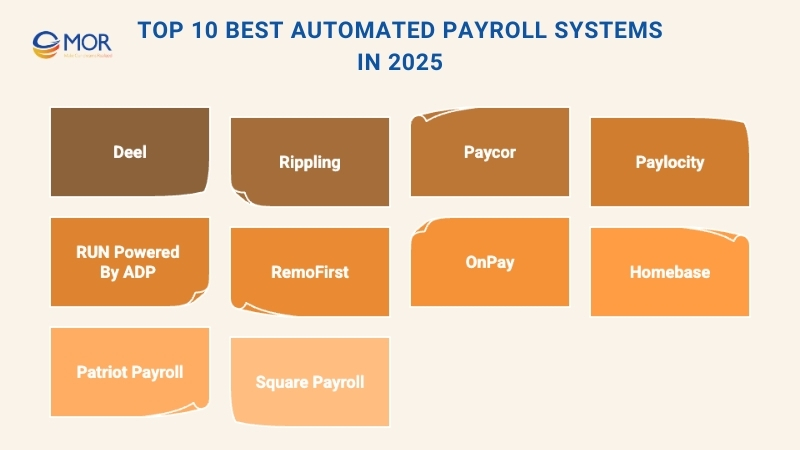
Deel
Best for international payroll management
- Free trial and demo available
- Plans start at $29/month
- Rating: 4.8/5
Deel is a trusted automated payroll software built to manage payroll across multiple countries from one central hub. It removes the complexity of tax calculations, deductions, and compliance by handling them automatically. Employers can save both time and money while making sure staff are paid promptly and accurately.
Deel also provides an Employer of Record service, where its in-house payroll experts manage local requirements such as 13th-month pay or vacation accruals. Using a simple dashboard, companies can schedule mass payments, with Deel generating direct deposits and pay slips automatically. The platform also includes built-in tax filing tools, further simplifying payroll administration.
For contractor management, Deel supports various contract types and multiple withdrawal methods like Wise and Payoneer. It also adds security through two-factor authentication, giving businesses peace of mind during payment processing.
Deel connects seamlessly with accounting and HR system integration, offering both pre-built and open API integrations. Popular integrations include BambooHR, QuickBooks, Xero, Netsuite, Greenhouse, Workday, and Hibob, which makes it easier to sync payroll data across the HR stack.
Overall, Deel is an excellent choice for organizations with global teams that want to simplify payroll without relying on manual processes or juggling separate platforms. Pricing is transparent, and companies can request a flat rate or start with a free demo.
Pros:
- Supports payments in over 150 currencies, including cryptocurrency
- Provides protection up to $25,000 for misclassification or legal disputes
- Includes employer of record (EOR) services alongside payroll
Cons:
- No mobile application available
- Lacks a free trial option
Rippling
Best for one-click payroll runs
- Free demo available
- Pricing from $8 per user/month (billed annually)
- Rating: 4.8/5
Rippling is an automated payroll system designed to make running payroll as simple as clicking “Run.” It enables businesses to pay employees and contractors worldwide in just a few minutes. Because it syncs directly with HR data, every payroll cycle is fast, accurate, and hassle-free.
The platform takes care of compliance automatically, managing forms, regulations, and payroll tax filings on schedule. Employers can also create and enforce custom paid-time-off policies, while approvals and balances sync directly into payroll records.
Rippling comes with a library of pre-built reports and the ability to design custom reports to meet business needs. The system integrates with popular platforms like Dropbox Business, Gmail, Google Workspace, PayPal, Slack, and Trello, making it easy to connect payroll with daily business tools.
Pros:
- Pay only for the services you use
- Tracks both billable and non-billable hours
- Frequently updated with new features
Cons:
- Some issues reported when using browsers other than Chrome
- Limited phone support options
- Reporting tools may lack depth compared to other providers
Paycor
Best for pre-scheduling payroll cycles
- 30-day free trial available
- Pricing on request
- Rating: 4.1/5
Paycor is an automated payroll system that helps businesses streamline payroll with flexible scheduling and user-friendly tools. Core features include general ledger integration, AutoRun capabilities, employee self-service, OnDemand Pay, and detailed management reporting.
The platform walks administrators through payroll runs step by step, offering real-time calculations before processing. Companies can schedule payroll for specific dates and times, eliminating the need for manual follow-ups.
Paycor is updated regularly to align with local, state, and federal regulations. It also supports flexible pay methods like direct deposit and pay cards, plus earned wage access, which allows employees to access part of their pay right after a shift.
The software integrates with applications like Benefit Allocation Systems, GoCo, WorkforceHub, SwipeClock, Boss Insights, and MyEnroll360, making it a strong fit for companies looking to expand payroll automation within their existing HR tech stack.
Pros:
- Easy-to-use system with a simple learning curve
- Customizable reporting options
- Saves both time and money on payroll runs
Cons:
- Time card functionality is limited
- Occasional system freezes reported
- Interface design feels dated compared to competitors
Paylocity
Best for midsize and large companies looking to scale
- Free demo available
- Pricing on request
- Rating: 4.5/5
Paylocity is a cloud-based automated payroll system built to support growing midsize and enterprise-level businesses. It automates payroll tasks with precision, ensuring accuracy, compliance, and smooth handling of employee compensation so HR teams can focus on higher-value work.
The platform includes a self-service portal, giving employees easy access to pay stubs, tax forms, and other payroll-related details. Standout tools include wage garnishment management, which removes the hassle of manual deductions, and global payroll functionality for handling multiple currencies and international regulations.
Employees also benefit from on-demand pay options, offering early access to wages when needed for greater financial flexibility. Additional features include automated tax filing, payroll scheduling, compliance tracking, benefits administration, and time-and-attendance management, all in one connected system.
Pros:
- Strong fit for midsize and enterprise businesses
- Global payroll support with multi-currency compliance
- Employee self-service portal for pay and tax information
- Automated tax filing and payroll scheduling
- On-demand pay options for employee flexibility
Cons:
- Pricing details not publicly transparent
- May be more complex than smaller businesses need
- Advanced features can require extra setup and training
RUN Powered By ADP
Best for small businesses
- 90-day free trial available
- Pricing on request
- Rating: 4.1/5
RUN Powered by ADP is an automated payroll system tailored for small business owners who want a simple yet flexible payroll solution. Companies can start with a basic payroll setup and expand into a full HR suite as their needs grow.
Key payroll features include automated tax calculations, accurate deductions, and submission of quarterly and annual reports. The system also stays updated with compliance changes, reducing the risk of errors. Time tracking can be integrated to manage payments for remote teams or hourly staff, keeping payroll aligned with work hours.
The platform provides a clear, personalized dashboard showing upcoming payroll runs, task reminders, payroll history, and easy navigation. Guided steps make payroll management straightforward, even for first-time users.
RUN integrates with tools like JazzHR, QuickBooks Time, ClockShark, Ease, and JobScore, helping businesses extend automated payroll services within their broader HR and finance systems.
Pros:
- Built-in time tracking integration
- User-friendly dashboard with clear navigation
- Simple to operate for small teams
Cons:
- Customer support response can be slow
- Employee Access Hub may experience glitches
- Payroll entries cannot be edited after posting
RemoFirst
Best for managing payroll across multiple countries and currencies
- Free demo available
- Pricing: $25–$199 per user/month
- Rating: 4.5/5
RemoFirst is a global employment platform that enables businesses to hire, pay, and manage international teams without setting up local entities. It helps HR, finance, and legal teams handle the complexities of international employment while making global workforce management more accessible.
The platform’s automated payroll software supports operations in over 170 countries, processing payments in multiple currencies while staying compliant with each region’s tax rules. Finance teams can consolidate invoices into one aggregated payment instead of sending separate transactions for every international employee. Workers also receive payments in their local currency, which improves accuracy and employee satisfaction.
As an Employer of Record (EOR), RemoFirst takes on legal responsibility for payroll compliance, reducing risks and administrative overhead for companies. It also supports international contractors by ensuring adherence to local labor laws, visa requirements, work permits, and conducting background checks when needed.
RemoFirst integrates with ADP, extending its reach for organizations already using payroll automation tools.
Pros:
- Simplifies remote team management across countries
- Strong customer support services
- User-friendly interface
Cons:
- Limited third-party integration options
- May require training for complete adoption
OnPay
Best for managing tips and commissions
- 30-day free trial available
- Pricing: $40/month + $6 per user/month
- Rating: 5/5
OnPay is a payroll platform built for small businesses that need flexibility and simplicity. It allows payroll to run on any schedule, including multiple pay cycles for different employee groups, making it highly adaptable for restaurants, retail, or service industries.
The software handles all payroll tax withholdings, processes payments, and files tax forms automatically. Both W-2 employees and 1099 contractors can be paid through direct deposit, debit cards, or checks from the same dashboard. Garnishments are easy to set up, and details are instantly reflected in pay stubs and expense reports.
A standout capability is its ability to add extra payments like tips and commissions, which is why OnPay is often chosen by businesses with variable pay structures. The platform also includes advanced reporting that can be filtered by employee type, department, or location, giving managers greater payroll visibility.
OnPay integrates with a wide range of systems, including QuickBooks Desktop, QuickBooks Online, QuickBooks Time, Xero, Deputy, PosterElite, and When I Work. These integrations extend the benefits of automated payroll system integration into accounting and workforce management.
Pros:
- Broad HR features built into the system
- Budget-friendly pricing for small businesses
- Unlimited payroll runs included
Cons:
- No live phone support during weekends
- Few plan options compared to competitors
- Limited benefits enrollment tools
Homebase
Best for mobile-first hourly teams
- Free plan available
- Pricing: from $20/location/month
- Rating: 4.2/5
Homebase is an all-in-one automated payroll software built for small businesses with hourly staff. It simplifies payroll by combining time tracking, scheduling, and wage calculation into one platform. The system automatically records hours, breaks, wages, and taxes in real time, helping businesses stay compliant without relying on manual spreadsheets.
The platform includes time clocks, PTO tracking, and employee self-onboarding. Its auto-payroll feature allows payroll to run automatically, with tax filings managed for all 50 U.S. states. Businesses benefit from faster turnaround with next-day payroll, ensuring employees are paid on time.
Homebase supports unlimited payroll runs and offers payment via direct deposit or check. It also automates compliance tasks such as new hire reporting, W-2s, and 1099s. Its mobile-first approach makes it easy for managers to run payroll directly from their phones, giving flexibility when on the move.
Integrations extend the value of this automated payroll system, with pre-built connections to platforms like Square, QuickBooks, Shopify, Toast POS, Stripe, Lightspeed, Clover, Gusto, Paychex, and ADP.
Pros:
- Fully automated payroll and tax filing
- Direct deposit or check payment options
- Accurate time tracking linked to payroll
Cons:
- Payroll is only available as an add-on feature
- Limited customization for unique business needs
Patriot Payroll
Best for US-based businesses
- 30-day free trial available
- Pricing: $17/month base fee + $4 per employee/month
- Rating: 5/5
Patriot Payroll is a U.S.-focused automated payroll system that simplifies payroll processing and tax management for small and midsize businesses. It supports direct deposits, check printing, payroll reporting, and automatic submission of state and federal taxes, helping employers stay compliant with less manual effort.
Employees can log in through a personalized portal to view payroll data, access financial details, and download year-end tax forms like W-2s. The platform also makes it easy to create, print, and share reports in formats such as PDF or CSV, keeping payroll information accessible and organized.
Available in both basic payroll and full-service packages, Patriot Payroll consistently earns high ratings for affordability and reliability. It is recognized as one of the most cost-effective solutions in the payroll software space.
The system also integrates with Patriot HR and Patriot TIME, extending its functionality to cover HR and time management in a unified solution.
Pros:
- Simple to use and dependable for payroll runs
- Supports payments for both employees and contractors
- Affordable and strong value for money
Cons:
- Some payroll reports can be difficult to interpret
- No global payroll support
- Employee app not available
Square Payroll
Best for built-in time tracking
- Pricing: $35/month base fee + $6 per user/month
- Rating: 4.2/5
Square Payroll is an online automated payroll system built to simplify employee payments and tax management. It comes with tools for payroll automation, benefits administration, and automatic tax filing, making it easier for businesses to stay compliant.
The platform tracks workers’ compensation and manages payments for salaried staff, hourly employees, and contractors in one place. Hours worked are pulled directly from the Square Point of Sale app, ensuring accurate payroll runs. It also calculates labor costs and paid time-off automatically, giving managers clear visibility into expenses.
Square Payroll integrates smoothly with Square POS, QuickBooks, and other employee management and accounting systems, creating a connected payroll and payment ecosystem.
Pros:
- Simple, user-friendly interface
- W-2 preparation tools make tax filing easier
- Employee mobile app available
Cons:
- Reporting features are limited
- Employer dashboard offers only basic functions
- Same-day payroll scheduling not supported
Risks Of Automated Payroll Systems Compared To Manual Payroll
Even though an automated payroll system brings major benefits, businesses should also be aware of potential risks. Addressing these issues early helps ensure smoother adoption and long-term success.
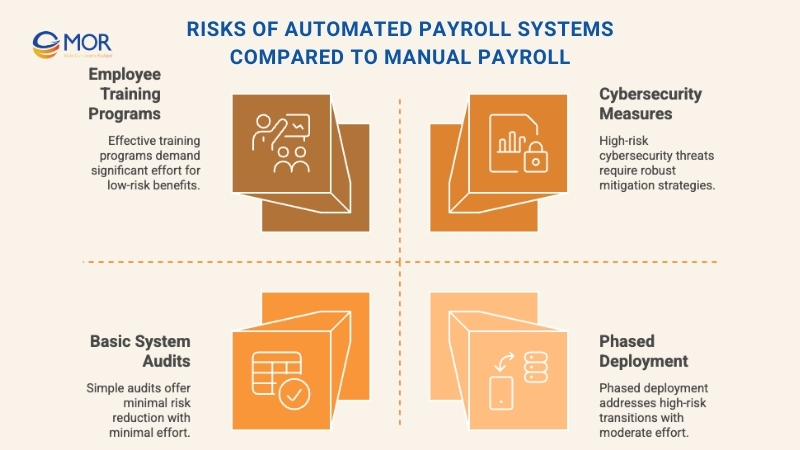
Integration Errors
Setting up an automated payroll platform requires accurate data transfer and proper syncing with current HR and finance tools. Mistakes during this stage, such as incorrect employee details or payroll configurations, may cause miscalculations, late payments, or compliance problems.
How to reduce risk: Run detailed audits and testing during setup to catch issues before launch. Work closely with the provider to guarantee smooth payroll auto integration and reliable data migration.
Cybersecurity Concerns
Most modern payroll platforms are cloud-based, which introduces risks like data breaches or unauthorized access to employee records. With sensitive financial and personal data involved, security becomes a top priority.
How to reduce risk: Select a system with strong safeguards like encryption, multi-factor authentication, and regular system updates. Schedule audits and monitor protocols to stay aligned with data protection regulations.
Employee Training And Adoption
Adopting a new automated payroll system often involves a learning curve. Without proper training, employees may misuse features or fail to take full advantage of the payroll automation software. Resistance from teams can also slow adoption and create unnecessary payroll disruptions.
How to reduce risk: Deliver training that covers core functions, frequent mistakes, and troubleshooting steps. Encourage open feedback channels so staff feel supported and confident using the new system.
System Downtime During Transition
Shifting from manual payroll to automation can sometimes result in temporary downtime. Unexpected technical issues during rollout may interrupt payroll cycles and affect employee satisfaction if not handled properly.
How to reduce risk: Deploy the system in phases and run parallel payroll cycles to detect discrepancies before going live. Keep a backup plan in place to maintain payroll continuity if downtime occurs.
By preparing for these risks in advance, organizations can achieve the full benefits of automation while maintaining reliability, security, and trust across their payroll operations.
>>> READ MORE: Create Payslip Online: Fast, Easy & Legal Payroll in 2025
How To Get Started With An Automated Payroll System?
Implementing automated payroll software doesn’t need to be overwhelming. With careful planning, you can roll out the system smoothly and see results quickly. Follow these five steps:
Assess Your Current Payroll Process
Look at your existing workflows to find bottlenecks, recurring errors, and tasks that consume too much time. These areas will show where payroll outsourcing companies can have the biggest effect.
Define Clear Priorities With HR And Finance
Work together to decide what success looks like. Whether it’s cutting down payroll errors, saving hours of admin work, or improving compliance, clear priorities guide smart decisions.
Introduce Systems In Phases
Rolling everything out at once can feel overwhelming. Instead, launch the system in stages, perhaps in one department or for a small group first. Run parallel cycles to test accuracy before going companywide.
Train And Support Your Team
The value of a new payroll platform depends on how well teams use it. Provide hands-on training, create resources for common issues, and encourage questions to build confidence.
Track Performance And Keep Improving
Once your automated payroll system is in place, use real-time data to measure outcomes and uncover new ways to optimize performance. Payroll automation is not only about addressing today’s needs but also about preparing your business for tomorrow’s challenges.
If your business needs a payroll automation solution that adapts to unique workflows and long-term goals, then working with a trusted development partner is essential.
MOR Software specializes in designing and developing custom enterprise applications that integrate payroll automation into broader HR and financial systems. Our dedicated teams ensure every solution is scalable, compliant, and tailored to your organization’s long-term strategy.
Conclusion
Choosing the right automated payroll system can transform payroll from a repetitive task into a strategic business function. With the right automated payroll services, companies gain accuracy, speed, and compliance while reducing the burden on HR and finance teams. Whether you’re looking to integrate with existing HR tools or create a fully customized platform, we’re here to help. Contact us today to start building a payroll system that grows with your business.
MOR SOFTWARE
Frequently Asked Questions (FAQs)
What is an automated payroll system?
An automated payroll system replaces manual payroll tasks with digital processes that calculate wages, manage deductions, and generate payslips automatically. It reduces human error, saves time for HR and finance teams, and ensures employees are paid accurately and on schedule. These systems also help organizations maintain compliance and streamline payroll management.
Can ChatGPT do payroll?
ChatGPT itself does not run payroll, but it can assist professionals by generating payroll reports, drafting templates, and analyzing data when provided with the right inputs. When paired with accounting software or HR tools, it can enhance efficiency by helping finance teams interpret results and prepare documentation.
Can payroll be done by AI?
Yes. AI is increasingly used in payroll to automate repetitive tasks like calculations, tax deductions, and compliance checks. By minimizing manual intervention, AI systems improve speed and accuracy. Research shows that organizations using AI-powered payroll software report higher efficiency and fewer payroll errors.
How to automate a payroll process?
To automate payroll, start by reviewing your current process and identifying bottlenecks. Next, choose a payroll platform that fits your company’s size and compliance requirements. Prepare and migrate your employee data into the new system, then run tests to confirm accuracy before going live. This step-by-step approach ensures a smooth transition.
How do you create a simple payroll system?
A basic payroll system involves registering for an Employer Identification Number (EIN), gathering employee details, and choosing a pay schedule. From there, you record compensation terms, classify workers correctly, and select payroll software to handle calculations and payments. This structure helps small businesses pay employees consistently and stay compliant.
Is there any free payroll software?
Yes. Some platforms provide free payroll tools for small businesses. For instance, Payroll4Free allows you to enter employee data, process payments, and get support without a subscription fee, making it suitable for budget-conscious teams.
What are the 5 basic steps of using the payroll system?
The payroll process typically follows five steps:
- Gather employee information.
- Calculate gross pay.
- Deduct taxes and withholdings.
- Distribute payments.
- Record payroll data for compliance.
This sequence ensures employees are paid correctly and companies keep accurate records.
Is payroll going to be automated?
Yes. Payroll is rapidly moving toward full automation as businesses seek to cut down on errors, save time, and meet compliance standards. Automated payroll solutions are becoming standard across industries, making payroll faster, more reliable, and easier to manage.
Rate this article
0
over 5.0 based on 0 reviews
Your rating on this news:
Name
*Email
*Write your comment
*Send your comment
1